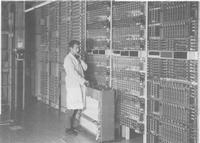


Chapter 8
I Part 1: Communications
i Before the Telegraph
ii Electrical Communication Before Federation
iii Federation to the End of the Second World War
iv Post-war and on to 1975
v 1975 ONWARDS
II Epilogue
III Part 2: Early Australian Computers And Computing
IV Acknowledgements
References
Index
Search
Help
Contact us

Post-war and on to 1975 (continued)
Australia may well have led the world in the development of centralised network performance and analysis centres, commencing with experimental work in Adelaide in 1960 on the analysis and plotting of subscribers' complaints, under a system which became known as CARGO (Complaints Analysis, Recording and Graphing Organisation). The new approach was to bring together in one centre the complaints for an area and to identify fault patterns through accumulating the effects of individual faults and studying the likely path of affected calls through the network. Omond, who was responsible for detailed work in Adelaide, has given an account of the experiment and of the development of the plotting process and the interpretation methods utilised.[50]Automatic routiners were increasingly used as a method of detecting defective apparatus. Available routiners of an early design, however, stopped and gave an audible alarm on detecting a situation which required attention, a feature which required staff in attendance. O'Mullane[51] has described an automatic recording scheme developed in Melbourne which enabled a routiner to test a group of selectors and record the necessary particulars of every switch failure disclosed during the test. The next development was to provide an installation in which the one recorder could serve all automatic routiners in the exchange.
Another requirement for determining the standard of service in the network was the ability to direct artificial traffic through the network. Initially this was done using equipment developed for use in the British Post Office, but this had several disadvantages. Petrie and Taylor[52] have given an account of work undertaken to adapt group selector routiners for artificial traffic generation and the design of a relay set which could be used at a remote location.
When ARF 102 crossbar was introduced into the network in 1963, a comprehensive approach to maintenance of the new equipment, built around the extensive use of supervisory and test equipment which the system incorporated, had to be developed. A. D. Pettersson, who was one of those closely involved, has given an account of the practices involved.[53] With the new equipment widely dispersed through the network, in order to obtain the advantages of common control facilities, there were many relatively small installations, a feature which led to work directed towards the development of facilities for centralising some aspects of crossbar maintenance. The APO, with Pettersson playing an important role, developed a supervisory system known as Automatic Disturbance Recording (ADR), using information obtained from experiments conducted in the relatively large Haymarket (Sydney) crossbar exchange. The development of ADR, involved equipment to give:[54]
- Interface equipment for conversion of the supervisory information to a form suitable for telemetering,
- storage and control units to handle the transmission of the information,
- the ability to decide the degree of urgency of the supervisory message,
- telemetry transmission and reception equipment for transmitting supervisory information from the exchange equipment to any desired location and for the reception of operational commands which may be used for control functions,
- supervisory messages transmitted in a form suitable for machine, including computer, processing.

Organisations in Australian Science at Work - Complaints Analysis, Recording and Graphing Organisation (C.A.R.G.O.)
People in Bright Sparcs - O'Mullane, G. V.; Ormond, D. J.; Petrie, K.; Petterson, A. D.; Taylor, J. B.
 |
Australian Academy of Technological Sciences and Engineering |  |
© 1988 Print Edition pages 585 - 588, Online Edition 2000
Published by Australian Science and Technology Heritage Centre, using the Web Academic Resource Publisher
http://www.austehc.unimelb.edu.au/tia/566.html